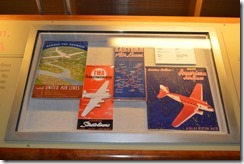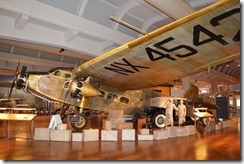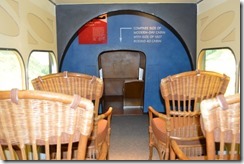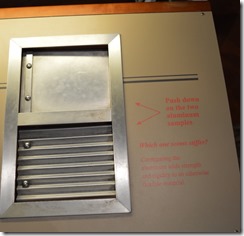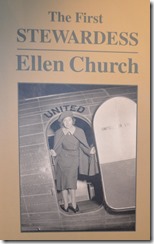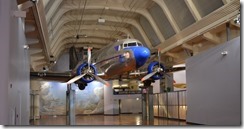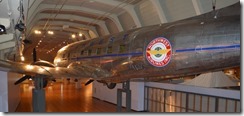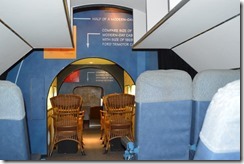One of the aspects I enjoy about hotel loyalty programs is I frequently end up in a location solely due to a hotel award stay or a low hotel rate to fulfill a promotion. This week my use of Marriott Rewards MegaBonus category 1-4 certificates placed me in Dearborn, Michigan at The Henry, a Marriott Autograph Collection hotel. If I had soon-to-expire Category 1-5 certificates, I would have likely been in downtown Detroit instead.
Being in Dearborn led me to visit the Henry Ford Museum, one of the top museums in the USA. I had never heard of the Henry Ford Museum before last week. Due to Marriott Rewards I discovered a museum gem in the metro Detroit area.
The Henry Ford, in Dearborn, Michigan, is the world’s premiere history destination that celebrates 300 years of American history and innovation.
Our mission is to provide unique educational experiences based on America’s traditions of ingenuity, resourcefulness and innovation. Our purpose is to inspire people to learn from these traditions and shape a better future. The Henry Ford holds 26 million authentic artifacts and documents including Thomas Edison’s Menlo Park laboratory, the bus on which Rosa Parks refused to give up her seat, the Wright Brothers’ home and cycle shop, and Buckminster Fuller’s Dymaxion House.
Five distinct attractions at The Henry Ford captivate and inspire more than 1.5 million visitors annually: Henry Ford Museum, Greenfield Village, The Ford Rouge Factory Tour, The Benson Ford Research Center and The Henry Ford IMAX Theatre.
History Of Commercial Aviation at the Henry Ford Museum
I enjoy learning about how things were and developed into how things are now. The Henry Ford Museum has an exhibit on the early history of air travel with more than a dozen aircraft. Here are some photos of planes and information from the museum exhibits on early commercial aviation.
Who was the first passenger airline?
Airlines had minimal regulations in the early years. Plane travel was a novelty and often dangerous.
In 1913, a hydroplane offered scheduled service across the San Francisco Bay between Oakland and San Francisco.
In 1914, the St. Petersburg-Tampa Airboat Line offered $10 trips across the bay. The air service makes 97 trips and carries 184 passengers, but the flights ceased at the end of tourist season.
In 1919, the first true passenger service is started by Alfred Lawson (1869-1954). He was a professional baseball player and manager, and became enthusiastic about early aviation. Lawson started one of the first trade journals, the magazine Fly in 1908. He moved to New York and renamed the magazine Aircraft, published until 1914. He was the first advocate of commercial aviation and coined the term airline. In 1917 he built his first airplane and founded the Lawson Aircraft Corporation.
His Lawson L-2 biplane was the first passenger airliner with 18 seats. On a 2,000 mile publicity tour, Lawson gained positive press for his commercial aircraft and secured $1 million to build the 26-passenger Midnight Liner. In 1926 he built the 56-seat two-tier Lawson super airliner. The aircraft crashed on takeoff during its maiden flight. Lawson left the commercial aviation industry for a career as a writer and lecturer on social reform of lifestyle, economics and philosophy.
Early Aviation funded by U.S. Mail Contracts
Early flyers like Lawson and Lindbergh started their aviation careers by securing U.S. mail air delivery contracts. In 1925 there were 420 private company airlines. These airlines competed for contracts and passengers.
In 1927 the cost to fly cross-country was about $400. This limited air travel to the wealthy in a time when the average American earned only around $1,200 per year. After Charles Lindbergh’s New York to Paris flight in 1927 the interest in commercial air travel grew four-fold in 1928. Around 150,000 passengers flew in 1929. Passenger air miles topped 84,000,000 in 1930. By 1936, airline passenger volume topped one million with 435 million air miles flown.
During the early depression years of the 1930s, many air carriers financially failed and the impact on air mail service resulted in Postmaster General Walter Folger Brown consolidating the existing network of U.S. postal routes into three cross-country routes. To secure one of these contracts many smaller airlines merged into larger airlines. The four major airlines emerging from consolidation increased airline passenger travel in the 1930s.
The Big Four Airlines after industry consolidation in 1930s included United Air Lines, TWA, Eastern Airlines and American Airlines.
Ford TriMotor – ‘The Tin Goose’
“That trip was an experience I’ll never forget…”
They gave us cotton to stuff in our ears, the ‘Tin Goose’ was so noisy. The thing vibrated so much it shook the eyeglasses right off your nose. In order to talk to the guy across the aisle, you had to shout at the top of your lungs. The higher we went, to get over the mountains, the colder it got inside the cabin. My feet nearly froze. The lavatory in the tail was so small that you barely squeeze through the door…
The leather-upholstered wicker-back chairs were about as comfortable as lawn furniture, and they were so narrow they pinched your fanny. When the plane landed on a puddle-splotched runway, a spray of mud, sucked in by the cabin air vents, splattered everybody.
— Arthur Raymond, on flying a Trimotor cross-country in 1932
(text from Henry Ford Museum display)
And you may think economy class airline travel is unpleasant in 2014.
Ford Trimotor metal aircraft.
The first flight of the Ford Trimotor was June 11, 1926. The Ford Trimotor was an all-metal design and advertised as a safer aircraft than traditional metal and wood planes of the 1920s.
The Ford Aircraft Division was the largest manufacturer of commercial aircraft in the late 1920s. Over 100 airlines used the Ford Trimotor and the plane was also flown by the U.S. Army Air Corps, U.S. Navy and Royal Canadian Air Force. Pan American Airways used Ford Trimotor extensively in the 1930s for its Caribbean routes. There were 199 Ford Trimotor aircraft produced between 1926 and 1933.
The Ford Trimotor was a durable aircraft and continued to operate in second-tier and third-tier airlines into the 1960s. There are 18 Ford Trimotor aircraft existing today.
Wicker seats of Ford Trimotor in an exhibit at Henry Ford Museum showing the cabin size of a 1927 Boeing 40 cabin (doorway in front) to cabin size of Ford Trimotor. Further back in this display is the DC-3 cabin which surpassed the Ford Trimotor as the leading aircraft of its day in the 1930s.
German aircraft designers had developed metal alloy planes prior to Ford. The Ford Trimotor design was actually developed by William Bushnell Stout whose Stout Metal Aircraft Company was acquired by Ford in 1925. Stout worked as an engineer for Ford until 1930. The single-engine Stout aircraft was improved into a three motor aircraft, hence Ford Trimotor. Bill Stout left Ford in 1930 and continued to design aircraft.
The corrugated metal of the Ford Trimotor improved the durability of the aircraft.
Ellen Church – The First Stewardess
In 1930, Ellen Church was a registered nurse at a San Francisco hospital. She was also a pilot. Boeing would not hire her as a pilot, but a senior Boeing executive in San Francisco liked the idea of an in-flight nurse to calm nervous passengers. She was hired as head stewardess for Boeing and she recruited seven other nurses for a three-month trial program for Boeing flights between San Francisco and Chicago.
On May 13, 1930 she was the flight attendant for a U.S. airline, or ‘sky girl’ as they were called by Boeing at the time, on a 20-hour flight with 13 stops and 14 passengers.
The pay was $125 for 100 hours of service.
Duties included:
- serving coffee, fruit cocktail, rolls and fried chicken.
- calming nervous passengers.
- aiding airsick passengers.
- passing out gum to help with air pressure sensitivity.
- passing out cotton to help with noise.
- making sure passengers did not open the exit door instead of the bathroom door.
- transferring baggage.
- helping refuel the plane.
- mopping the floors of the plane.
- finding food and shelter for passengers in case of unexpected stops.
Other airlines adopted stewardesses over the next few years.
Requirements to qualify as an airline stewardess in the 1930s
Age: under 25 years.
Weight: under 115 pounds.
Height: under 5’ 4”.
Marital Status: single
1939 Douglas DC-3
The Douglas Aircraft Company of Santa Monica, California developed the DC-3 which became the most prevalent passenger airliner of its time. Nearly 10,926 aircraft were built, primarily for military use. 803 aircraft went into civilian passenger service.
The DC-3 had a 19-passenger and 1-pilot configuration. The plane had a maximum speed of 190 mph.
1939 DC-3 Northwest Airlines
DC stands for Douglas Commercial. Transcontinental and Western Airlines (TWA) was in competition with United Airlines for passengers. Boeing Air Transport won the air mail contract in 1927 for the Chicago-San Francisco route. In 1931, Boeing’s passenger service was renamed as United Air Lines.
Boeing Air Transport’s 247 aircraft set the modern standard for passenger aircraft on its inaugural flight May 22, 1933 when it set the cross-country record for San Francisco to New York in 19.5 hours. This was eight hours faster than the Ford Trimotor and marked the first time passengers could fly across the US without changing planes or an overnight stop.
Another reason behind the development of the Boeing 247 was the 1931 TWA Flight 599 crash of a Fokker Trimotor linked to a structural failure due to wood rot of the wing. Knute Rockne, Notre Dame football sports legend, and seven others died on that flight. The aviation industry moved to all metal aircraft design.
In 1932, TWA sent out a letter requesting a new type of aircraft, one that would surpass the competition. The design had to include all-metal construction, three engines, 12-passenger capacity, 146 m.p.h. cruising speed, modern navigational equipment, a 1,080 mile range and 14,200 lb. gross weight.
Several airlines wanted the new 10-passenger Boeing 247, however, United Air Lines had an order of 60 aircraft tying up the production capacity for the aircraft. In response, TWA contracted with Douglas Aircraft to create its own airliner to remain competitive with United Air Lines. This resulted in the development of the prototype DC-1, DC-2 and finally the DC-3 in 1936.
The DC-3 set the standard for the airline industry. By 1939 DC-3 aircraft carried 80% of the world’s airline passengers and 90% of cargo traffic.
Size of DC-3 cabin compared to 1928 Ford Trimotor cabin.
William Boeing, Donald Douglas and Henry Ford were pioneers and innovators in the commercial airline industry of the United States. The Henry Ford Museum offers a fascinating and educational look at the development of airline travel.
Related Post: Aviation History at the Henry Ford Museum Part 1 (Jan 11, 2014)
*****
Blogger Disclosure: I am in the Detroit area for the North American International Auto Show (NAIAS) as a media attendee sponsored by the Ford Motor Company who paid for my flight from Monterey to Detroit. I came to Detroit three days early to sightsee before the Jan 12-14 NAIAS events. I paid for my own lodging, meals and sightseeing expenses for three days prior to the January 12 start of the #FordNAIAS event.
My visit to the Henry Ford Museum was not connected in any way to the #FordNAIAS event. I stayed at The Henry, Marriott Autograph Collection hotel in Dearborn using two free night certificates earned from 2013 Marriott MegaBonus promotion. The Henry Ford Museum is the top tourist attraction in Dearborn. I paid the standard $17 admission fee for the Henry Ford Museum.
Ric Garrido of Monterey, California is writer and owner of Loyalty Traveler.
Loyalty Traveler shares news and views on hotels, hotel loyalty programs and vacation destinations for frequent guests.
Follow Loyalty Traveler on Twitter and Facebook and RSS feed or subscribe to a daily email newsletter of Loyalty Traveler blog posts.


